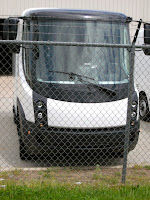One of the last items on the tour, (besides the military division where we did not have access) was the production of Isuzu “small” chassis equipped with gasoline engines. These are similar to the ones GM built prior to their reorganization. All gas engine chassis have a Spartan frame rail and body and a GM power train. The plant is running overtime to keep up the production. Some are being converted to run on natural gas or propane and EPA testing is currently underway for certification. There is no doubt that this mode of transport will become very popular with tradesman and delivery companies. There was even a crewcab model which is popular with landscapers so that they can take their crew along to the jobsite. Ultimately the hope is that they will be able to build the diesel models currently made in Japan and shipped to North America. Spartan is also shipping fire trucks to China and has begun training there as well. It looks like the economy is slowing coming back in the USA and the various interests they have developed in emerging economies will ensure this company prosper and grow in their southern Michigan location.
Owner as well as technician training is available in the extensive training facility located in Plant one (the service center) This four day course shows the owner the many subassemblies on a typical coach as well as how various components operate and are serviced. In addition a complete walkthrough of your coach is included with many helpful hints and techniques provided to make the owner experience even better.
All in all, this tour was a very informative and encouraging one. -- R.L.
This is part 3 of a 3 part series
---
Like what you've just read?
Tell your friends on facebook or twitter!
Tweet











